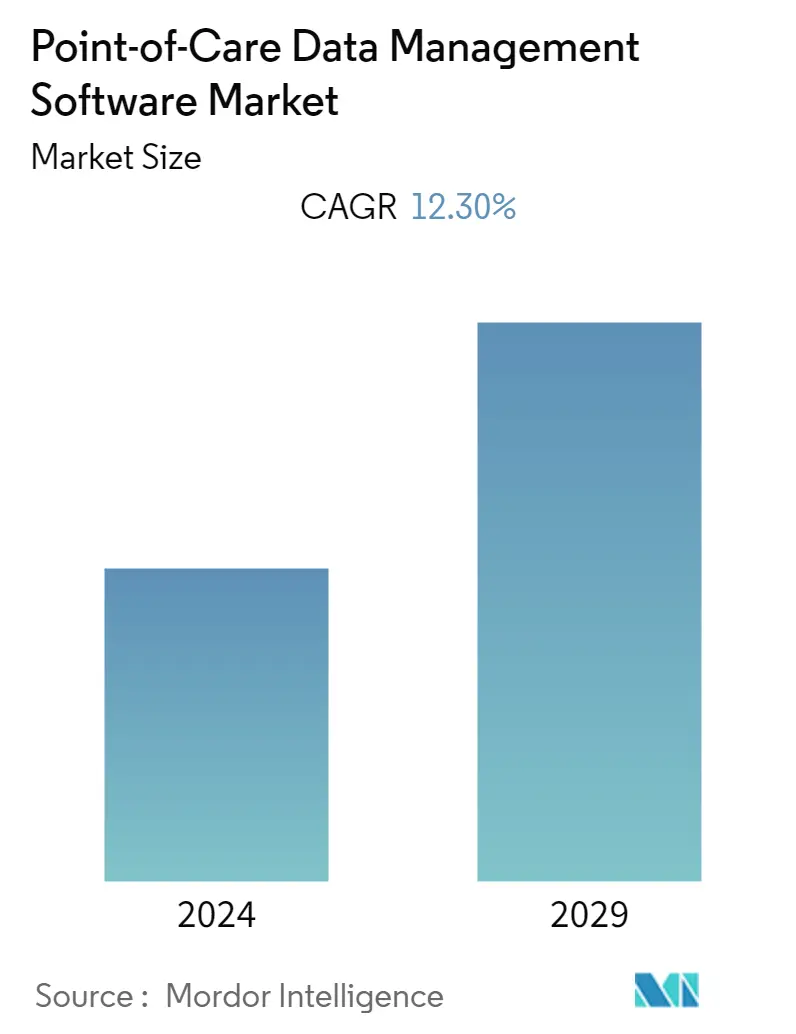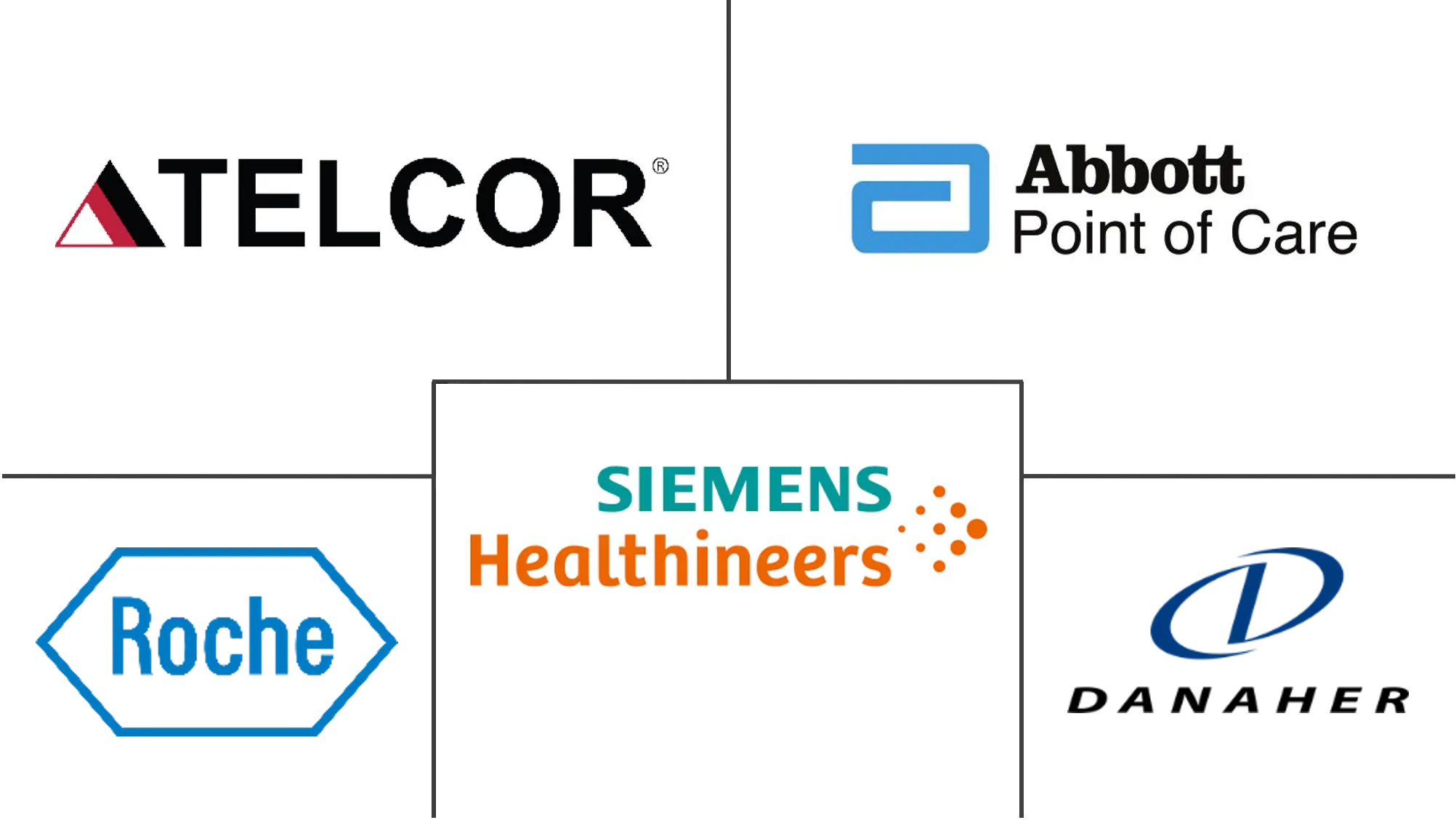Market Size of Point-of-Care Data Management Software Industry

| Study Period | 2019 - 2029 |
| Base Year For Estimation | 2023 |
| CAGR | 12.30 % |
| Fastest Growing Market | Asia Pacific |
| Largest Market | North America |
| Market Concentration | Medium |
Major Players
*Disclaimer: Major Players sorted in no particular order |
Point-of-Care (POC) Data Management Software Market Analysis
The POC data management software market is expected to register a CAGR of 12.3% over the forecast period. Point-of-care technologies enable hospitals and clinics to invest more time and money in technologies that help accelerate the patient flow through practice and streamline doctors' and nurses' daily workflow by reducing waiting times.
- The demand for point-of-care testing is growing in response to the value shift in healthcare and technological developments. Several factors are driving the need for POCT. Some of them include an increase in infectious diseases, a rise in lifestyle-related diseases, such as cardiac diseases and diabetes, a growing patient desire to use home-based POC devices, and technological advancements creating faster and easier-to-use devices.
- Around the globe, an estimated 511 million adults have diabetes. By 2040, this number is expected to rise to over 5,70 million. As diabetes worldwide continues to increase, so must the effort to raise awareness. 37% of all diabetic adults are expected to live in the Asia-Pacific region. Additionally, according to the International Diabetes Federation, the number of diabetic patients worldwide in 2021 was 537 million. Between 2021 - 2045, the global expenditures for diabetes treatment are anticipated to grow from USD 966 million to USD 1,053 million. According to a recent report by the Centers for Disease Control and Prevention (CDC), more than 50% of people with diabetes who have been diagnosed with COVID-19 are hospitalized.
- Rapid diagnosis of clinical conditions through point-of-care testing (POCT) can improve patient outcomes. The primary concept behind POCT growth is that bringing testing closer to the patient and results quickly and conveniently to the provider can speed up the diagnosis and treatment. Today's POCT devices are changing, but capturing the data required to document compliance is still time-consuming. A robust POCT management system and connectivity solution reduces the time spent manually typing in results, eliminates errors inherent to manually entered results, and facilitates real-time access to results so that providers can make timely decisions.
- Additionally, as healthcare data analytics are more commonly used to support patient-centered care and population health management, it is essential to have POCT results electronically integrated to include results tracking metrics and key performance indicators. Electronic medical records (EHR) expenditures in the United States grew at an annual average of 5.4% from 2015 to 2019, totaling USD 14.5 billion in 2019. Additionally, according to the Japanese Nursing Association survey, from September to October 2019, around 63% of the hospitals in Japan implemented the system of EMR. The government in the country has been promoting the system's use since the beginning of the 2000s.
- The COVID-19 outbreak placed a significant burden on healthcare systems worldwide that are straining to handle the volume of ill patients requiring life-saving treatment. Several countries have witnessed or are preparing for shortages of critical medical equipment such as surgical masks, face shields, life-saving ventilators, or even the physical space and beds for patients. These seemingly fundamental necessities become the priority in a world of increasingly high-tech healthcare equipment.
Point-of-Care (POC) Data Management Software Industry Segmentation
The study tracks the point-of-care data management integration software that would allow remote access of the POCT devices by acting as an interface between LIS and EMR solutions. The tool primarily aids the stakeholders in making quick clinical and diagnostic decisions, resulting in an analytics interface across multiple platforms while ensuring patient satisfaction.
The Point-of-Care Data Management Software Market is segmented by End User (Hospitals/Critical Care Units, Diagnostic Centers, Clinics/Outpatient), Application (Infectious Disease Devices, Glucose Monitoring, Coagulation Monitoring, Urinalysis, Cardiometabolic Monitoring, Cancer Markers, Hematology), and Geography.
| By End User | |
| Hospitals/Critical Care Units | |
| Diagnostic Centers | |
| Clinics/Outpatient |
| By Application | |
| Infectious Disease Devices | |
| Glucose Monitoring | |
| Coagulation Monitoring | |
| Urinalysis | |
| Cardiometabolic Monitoring | |
| Cancer Markers | |
| Hematology | |
| Other POC Applications |
| By Geography | |||||||
| |||||||
| |||||||
| |||||||
| Latin America | |||||||
| Middle East & Africa |
Point-of-Care Data Management Software Market Size Summary
The Point-of-Care (PoC) Data Management Software Market is experiencing significant growth, driven by the increasing demand for efficient healthcare solutions that enhance patient care and streamline clinical workflows. PoC technologies are becoming integral in hospitals and clinics, facilitating faster patient diagnosis and treatment by bringing testing closer to the patient. This shift is largely due to the rising prevalence of infectious and lifestyle-related diseases, advancements in technology, and the growing preference for home-based testing devices. The market is characterized by a competitive landscape with key players like Siemens Healthineers AG, Abbott Point of Care Inc., and Danaher Corporation, who are focusing on product innovation and strategic partnerships to expand their market presence.
The market's expansion is further fueled by the integration of PoC testing with electronic medical records (EMR) systems, which enhances data management and reporting capabilities. This integration is crucial for supporting patient-centered care and population health management by providing real-time access to test results and analytics. The COVID-19 pandemic has accelerated the adoption of PoC testing, highlighting its importance in managing healthcare resources effectively. Additionally, partnerships and collaborations, such as those between Glytec and Roche, and Butterfly Network, Inc. and Ambra Health, are enhancing interoperability and data management solutions, thereby improving patient outcomes and operational efficiencies in healthcare settings.
Point-of-Care Data Management Software Market Size - Table of Contents
-
1. MARKET DYNAMICS
-
1.1 Market Overview
-
1.2 Market Drivers
-
1.2.1 Innovation in Flexible Connectivity and Software Interface Solutions
-
1.2.2 Rise in Healthcare Infrastructure Budgets
-
1.2.3 Government Initiatives for Promoting the Deployment of POC Testing
-
-
1.3 Market Challenges
-
1.3.1 High Deployment Costs and Operational Challenges
-
-
1.4 Market Opportunities
-
1.4.1 Rapid Testing and Decentralized Healthcare
-
-
1.5 Porters Five Force Analysis
-
1.5.1 Bargaining Power of Suppliers
-
1.5.2 Bargaining Power of Buyers
-
1.5.3 Threat of New Entrants
-
1.5.4 Threat of Substitutes
-
1.5.5 Intensity of Competitive Rivalry
-
-
1.6 Current Regulatory Landscape (Guidelines of Clinical Laboratory Improvement Amendments CLIA) and Connectivity Standards (POCT1-A2))
-
1.7 Emerging Applications in Point-of-Care Testing (Sepsis Biomarkers, Endocrine Testing, Stroke Markers, etc.)
-
-
2. MARKET SEGMENTATION
-
2.1 By End User
-
2.1.1 Hospitals/Critical Care Units
-
2.1.2 Diagnostic Centers
-
2.1.3 Clinics/Outpatient
-
-
2.2 By Application
-
2.2.1 Infectious Disease Devices
-
2.2.2 Glucose Monitoring
-
2.2.3 Coagulation Monitoring
-
2.2.4 Urinalysis
-
2.2.5 Cardiometabolic Monitoring
-
2.2.6 Cancer Markers
-
2.2.7 Hematology
-
2.2.8 Other POC Applications
-
-
2.3 By Geography
-
2.3.1 North America
-
2.3.1.1 United States
-
2.3.1.2 Canada
-
-
2.3.2 Europe
-
2.3.2.1 Germany
-
2.3.2.2 United Kingdom
-
2.3.2.3 Italy
-
2.3.2.4 France
-
2.3.2.5 Rest of Europe
-
-
2.3.3 Asia-Pacific
-
2.3.3.1 India
-
2.3.3.2 Japan
-
2.3.3.3 China
-
2.3.3.4 Singapore
-
2.3.3.5 Rest of Asia-Pacific
-
-
2.3.4 Latin America
-
2.3.5 Middle East & Africa
-
-
Point-of-Care Data Management Software Market Size FAQs
What is the current Point-of-Care Data Management Software Market size?
The Point-of-Care Data Management Software Market is projected to register a CAGR of 12.30% during the forecast period (2024-2029)
Who are the key players in Point-of-Care Data Management Software Market?
Siemens Healthineers AG + (Conworx), Abbott Point of Care Inc. + (Alere) , Danaher Company (HemoCue and Radiometer Medical ApS), Roche Diagnostics Corporation and TELCOR Inc. are the major companies operating in the Point-of-Care Data Management Software Market.

